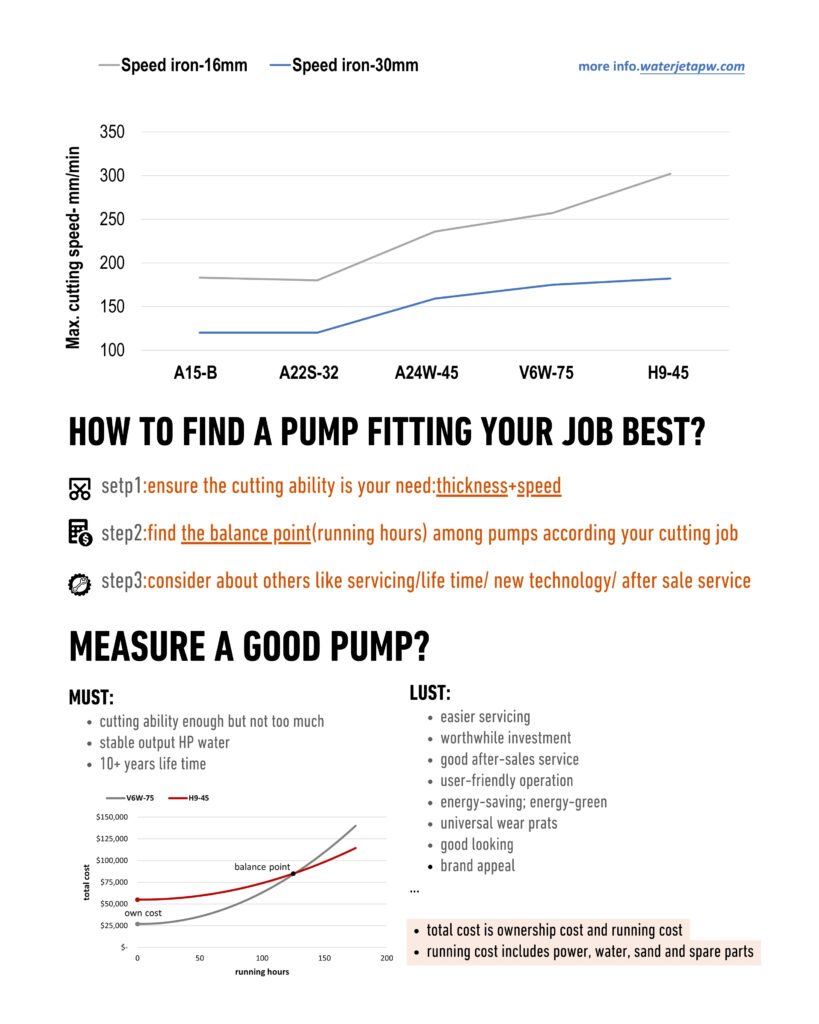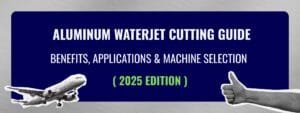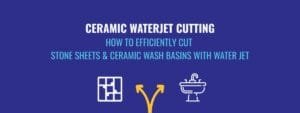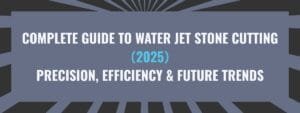Comparison costs in this article of water jet cutting and laser cutting from multiple perspectives to assist corporate decision-makers in financial decision-making. Processing conditions in this article are based on the average situation of China’s manufacturing industry, with amounts listed in both RMB and USD (CNY: USD = 7.1886). Costs and revenues such as energy prices, labor wages, and local processing fees may vary regionally. This article is only for reference – for personalized assistance. Contact APW WATER JET SALES. It is every machinery provider’s obligation to help customers maximize profits.
watch water jet cutting videos / download catalogs / check technology data
I. Comparison of Core Cost Dimensions
Comparison cost between water jet cutting and laser cutting includes 4 cost types below
| Cost Type | Laser Cutting | Water jet Cutting |
| Equipment Purchase Cost | – Small/medium-sized: $13,910–$27,820(¥100,000–200,000) – High-power industrial: $41,730–$139,100+(dependent on laser power/cutting format) | – Basic model: $8,290–$20,980(¥60,000–150,000) – 5-axis/high-pressure: $27,820–$62,890+(includes abrasive supply/water circulation systems) |
| Annual Operating Cost | – Power: $1,391–$4,173(¥10,000–30,000) – Consumables: $696–$1,391(¥5,000–10,000) – Maintenance: $1,113–$2,087(¥8,000–15,000) | – Power: $696–$2,087(¥5,000–15,000) – Consumables: $2,087–$6,960(¥15,000–50,000) – Maintenance: $1,391–$2,782(¥10,000–20,000) |
| Consumable Dependence | Low (only requires periodic replacement of minor wear parts) | High (abrasives are single-use consumables requiring continuous procurement) |
| Long-Term Cost Trend | – Laser source lifespan: 10,000–20,000 hours, replacement cost $1,391–$4,173(¥10,000–30,000)- Optical component maintenance costs increase with usage | – Nozzle lifespan: 50–100 hours, long-term consumables account for 30%–50% of total costs(nozzle replacement: $28–$70/piece, ¥200–500) |
II. Analysis of Cost Differences
1. Drivers of Purchase Costs
- Laser Cutting: Core costs derive from laser generators (fiber lasers/CO₂ tubes), optical systems (lenses/mirrors), and CNC platforms. Higher power (e.g., 4000W+ for thick materials) leads to exponential price increases.
- Water jet cutting: Major costs include high-pressure pumps (690 MPa class), abrasive mixing systems, and 5-axis cutting heads. Supporting wastewater treatment and abrasive recycling equipment also raises initial investment.
2. Key Variables in Operating Costs
- Laser Cutting: High power consumption (50–100 kWh/hour) but no solid consumables; maintenance focuses on optical system cleaning/calibration, with limited laser tube lifespan (CO₂: 2,000–5,000 hours; fiber lasers have longer life but higher repair costs).
- Water jet Cutting: Abrasive consumption is the largest variable (5–10 kg garnet/hour for 100 mm steel), with frequent nozzle wear from high-speed abrasives requiring replacement every 8–12 hours of cutting.
3. Impact of Economies of Scale
- Laser Cutting: Suited for mass production, with low unit allocation of equipment depreciation and power costs.
- Water jet Cutting: Higher abrasive waste/nozzle costs for small batches; bulk purchasing discounts reduce costs in large-scale applications (e.g., 24/7 operation).
III. Cost and Process Selection Recommendations
| Scenario | Priority for Laser Cutting | Priority for Water jet Cutting |
| Limited Budget | Small/medium equipment with lower initial investment (<$27,820), ideal for start-ups (¥200,000 ≈ $27,820) | Requires higher initial investment (>$20,980), with long-term dependence on consumable procurement (¥150,000 ≈ $20,980) |
| High Capacity Demand | Low unit time cost (fast cutting speed), suitable for assembly lines (e.g., 100,000 automotive parts/year) | More efficient for thick materials but requires managing abrasive inventory/handling (e.g., annual consumables for 50 mm carbon steel ≈ $6,960) |
| Environmental Compliance | Requires dust collection equipment (additional cost ≈ $696–$1,391, ¥5,000–10,000) | No exhaust emissions, recyclable wastewater/abrasives (compliant with ESG standards, enabling 20%–40% premium for medical-grade processing) |
Summary: Balancing Cost and Performance
- Laser Cutting: Optimal for thin material mass production and precision processing. Higher upfront investment but controllable operating costs, relying on technological upgrades (e.g., fiber lasers reducing maintenance costs).
- Water jet cutting: Ideal for thick materials, heat-sensitive materials, and multi-material processing. Lower equipment depreciation but continuous consumable expenses, suited for high-end manufacturing requiring strict material performance (aerospace, nuclear industry).
Comparison cost between water jet cutting and laser cutting. Select the optimal solution by integrating your capacity planning (annual output), material types (e.g., thick aluminum/carbon fiber), and environmental policies through total cost of ownership (TCO) analysis – including equipment, consumables, maintenance, energy, and labor.Comparison cost between water jet cutting and laser cuttingSelect the optimal solution by integrating your capacity planning (annual output), material types (e.g., thick aluminum/carbon fiber), and environmental policies through total cost of ownership (TCO) analysis – including equipment, consumables, maintenance, energy, and labor.水射流切割与激光切割的成本对比
通过总体拥有成本(TCO)分析,综合考虑产能规划(年产量)、材料类型(如厚铝/碳纤维)和环境政策,选择最优解决方案——成本分析涵盖设备、耗材、维护、能源和人工等方面。




